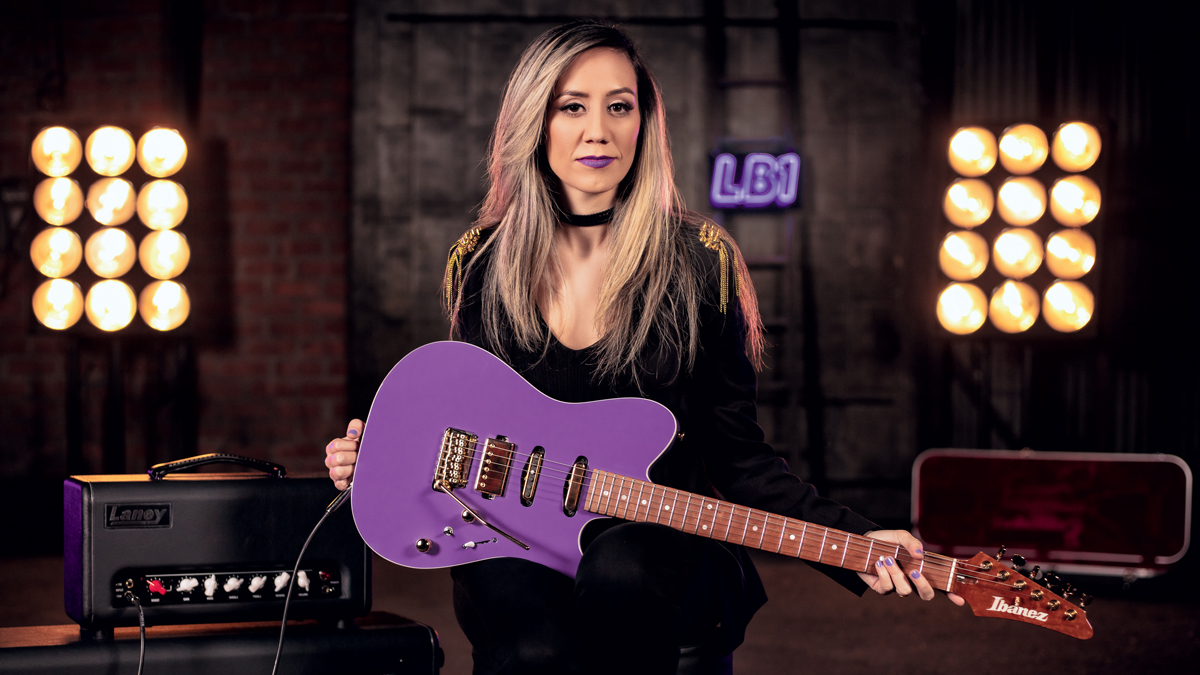Lari Basilio: “My plan with the Ibanez LB1 was to make an electric guitar that could do it all“
The Brazil-born virtuoso guides us through her new signature model, from tonewood exotica to working with Seymour Duncan, and that lipstick-inspired finish

“Growing up, the Ibanez generation of players like Joe Satriani and Steve Vai made such a big impression on me. When it came to my own signature model, Ibanez gave me so much freedom to put in all my ideas.
“My plan with the Ibanez LB1 was to make an electric guitar that could do it all. I wanted to have just one guitar that would serve me for everything I need as a player, because I try to be versatile in my style, my sound and my songs.
“My wood choices were all based on tone. I love the sustain and brightness of the ash body, and the roasted birdseye maple neck is just gorgeous, so beautiful. I love the S-Tech wood roasting treatment that Ibanez uses, which really increases the stability and durability.
“I think roasted maple necks just have a little more attack and sustain, and the compound radius fretboard gets flatter going up, which is the easiest for the size of my hands.


“The LB1 has my own signature pickups in an HSS configuration, and I had the absolute pleasure of working with Seymour Duncan, developing and voicing them especially for this guitar.
“With mag pickups, I like a T-style tone for the neck, so that was an essential feature. The middle pickup, I wanted to sound like an S-style single coil. The humbucker has a lot of attack and clarity – and then the Alter Switch lets me split it and gives lots of other possibilities.
“I like to play the whammy bar hard, y’know, up and down, front to back, so the Gotoh T1702B bridge and Magnum Lock machineheads were definitely important. I need to feel secure when I’m playing, to trust that the guitar is going to stay in tune.
Get The Pick Newsletter
All the latest guitar news, interviews, lessons, reviews, deals and more, direct to your inbox!
“The Luminlay dots on the side of the fretboard light up, too, so when you’re on a dark stage, you’re not blind, you’ll never be lost. That’s a great feature. I’ve had some hard times with other guitars that didn’t have it.
“The finish? I love purple. That actually started because of my favourite purple lipstick that I use all the time. People started relating that colour to me, then I started having purple laces on my boots as well. So I couldn’t think of a better colour for my first signature guitar.
For the LB1, Ibanez colour-matched the finish from my lipstick. That was one of the references that I sent them and they nailed it first time
“For the LB1, Ibanez colour-matched the finish from my lipstick. That was one of the references that I sent them and they nailed it first time. Prince was a big fan of purple, too. I’d have loved to have seen him play this guitar.
“The pandemic definitely changed our plans. It was challenging doing everything from a distance, but Ibanez nailed the LB1 in the first sample they sent me. I knew this was it. I felt at home immediately. I didn’t need any time to adapt to the guitar, which is the first time that’s happened. And my new single Sunny Days was the first song I wrote with it…”
Henry Yates is a freelance journalist who has written about music for titles including The Guardian, Telegraph, NME, Classic Rock, Guitarist, Total Guitar and Metal Hammer. He is the author of Walter Trout's official biography, Rescued From Reality, a talking head on Times Radio and an interviewer who has spoken to Brian May, Jimmy Page, Ozzy Osbourne, Ronnie Wood, Dave Grohl and many more. As a guitarist with three decades' experience, he mostly plays a Fender Telecaster and Gibson Les Paul.
“The most in-demand mods straight from the factory”: Fender’s elevated Player II Modified line brings the firm’s most sought-after guitar upgrades to the masses
“I used to weigh my guitars and use the heaviest one. As I’ve got older and my back’s got worse, lighter guitars are definitely better”: Lee Malia’s Jackson signature completes a full circle 20 years in the making – and it redefines what a Jackson can be


![John Mayer and Bob Weir [left] of Dead & Company photographed against a grey background. Mayer wears a blue overshirt and has his signature Silver Sky on his shoulder. Weir wears grey and a bolo tie.](https://cdn.mos.cms.futurecdn.net/C6niSAybzVCHoYcpJ8ZZgE.jpg)

![A black-and-white action shot of Sergeant Thunderhoof perform live: [from left] Mark Sayer, Dan Flitcroft, Jim Camp and Josh Gallop](https://cdn.mos.cms.futurecdn.net/am3UhJbsxAE239XRRZ8zC8.jpg)






